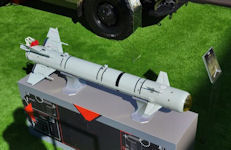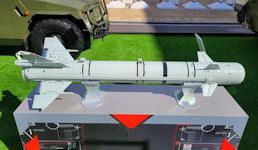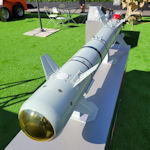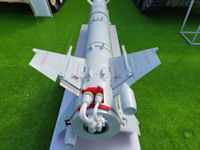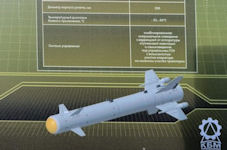Izdeliye 305 (Product 305 E)
Light multi-purpose guided rocket (LMUR)
The Izdeliye 70 (Product 70) and Izdeliye 305 (Product 305) are two totally different helicopter launched anti-tank guided missiles. The newest Mi-28NM and Ka-52M combat helicopters are equipped with the Product 305 missile. As for the electronic filling - yes, it is imported, not all, but a lot. The target for LMUR [legkaja mnogocelevaja upravljaemaja raketa = Light multi-purpose guided rocket] is important ground targets of the enemy, such as ammunition depots or fuel and lubricants. The missile is highly accurate and has several guidance modes, which simplifies the solution of combat missions.
The missile can operate on a fire-and-forget mode. "Product 305" is subsonic, but has an increased flight range - 14.5 km. In this regard, LMUR is superior to other modern missiles of its class. The increase in range allows the helicopter to attack a ground target with minimal risk to itself.
"Product-305" is one of the most" mysterious " developments of the Russian defense industry. For a long time, the appearance of the product was kept secret, and the data that appeared in the media were often contradictory. At the Army-2021 forum, Russia showed the Product-305 missile, which should be armed with new attack helicopters. It has a round-the-clock thermal imaging homing head.
The "305E" has a mass of 105 kilograms, a length of 1945 millimeters and a body diameter of 200 millimeters. The product received a 25-kilogram high-explosive fragmentation warhead. Thanks to the solid-fuel engine, the rocket can reach speeds of up to 250 meters per second. The controlled firing range is up to-14.5 kilometers. The flight altitude is from 100 to 600 meters.
The novelty has a combined guidance system. The use of inertial-satellite guidance is supposed to be used on the marching section, the product is aimed directly at the captured target using a thermal imaging GPS. The missile is accompanied by a radio channel and at the final point of guidance it can be re-aimed at the operator's command.
The normal mode is to launch at a target that is visible visually. In the case of shooting at an "invisible" object, a highly qualified operator is needed. The rocket is launched using APU-305 devices, which are designed for one or two missiles.
The Mi-28NM attack helicopter is able to take up to four Product-305 missiles. The weapon will allow the machine to more effectively destroy both manpower and strategic objects, such as enemy command posts. Another carrier of the "Product-305" will be the upgraded Ka-52M helicopter. A few years ago, it became known that [...] a large batch of such machines would be delivered to the Aerospace Forces. According to the sum of the indicators, the Mi-28NM and Ka-52M are the most powerful Russian attack helicopters (the ability to use the "Product-305" is an important, but not the only difference between them).
"Product 305E" was adopted by the Russian Armed Forces in 2021. The Mi-28NM helicopter can carry up to eight LMURs. The difference compared to the Attack is only in the greater range and guidance system. The attack did not have its own camera and the camera on board was used. This required a direct line of sight to the target from the moment of launch to hit. And with the product 305, helicopters can turn around and leave immediately after launch. ATGMs do not work with pitch-up, only NURs themselves.
The missile’s range of 14.5 kilometers, as well as a very small loss of altitude when launched from a carrier, makes it possible to use it from a distance at which portable anti-aircraft missile systems, machine guns and small-caliber anti-aircraft artillery cannot reach it in range, and full-fledged anti-aircraft missile systems will be very it is difficult to detect an aircraft flying at an ultra-low altitude.
The future LMUR missile was developed by the Kolomna Design Bureau of Mechanical Engineering. According to known data, the Ministry of Defense acted as the original customer of this missile - then the product was number 79. But then the military began to save on matches, not accepting and not paying for the already completed stages of work, and then they covered the topic altogether. A relatively small number of samples were ordered for testing, funding is typical for the MoD - a small advance, and payments at the end of the R&D stages. In view of the failure to meet the deadlines , the stages were not signed and paid. The topic could really stall and close, never reaching the test.
It is curious that the Federal Security Service, and not the Ministry of Defense, as usual, acted as the customer for the product. The 305 missile was intended for the FSB aviation and was to be used with special modifications of the Mi-8 helicopter. Additions were made to the initial TOR (a radio link was added - to control the target being hit and the ability to "retract" at the last moment if the intelligence was not correct). The launch mode for an unobserved target was not considered due to the specifics of the "work" of the customer. Many times more items were ordered. The issue of financing was removed - 100% advance payment for all work (all stages) at once, at a time.
The product code was changed to "product 305". The project was completed by the middle of the decade, after which the "305" passed the necessary tests and was recommended for the series. The production of missiles for the FSB began in 2016. By that time, the Russian Air Force also became interested in the project, also wanting to get a modern light aircraft missile. After the necessary checks and procedures, the LMUR entered service.
The first known picture of the Product 305 date from 2013, when it was shown with the Mi-28MN attack helicopter, revealing a system resembling the current Shturm and Ataka anti-tank missiles. at that time, none of those who took and saw the pictures did not know what the "PU with a plate" was for, so they did not pay much attention to them.
The Russian modernized attack helicopter Mi-28NM will receive a new guided missile “product 305” with a target range of over 25 km. This was reported to TASS on 20 March 2019 by a source in the aircraft building complex. “For the Mi-28NM, a new missile is being created, the “product 305”, designed for round-the-clock destruction of armored vehicles and reinforced concrete fortifications. The range of missile use is more than 25 km,” the agency’s source said. The source added that one helicopter can carry up to eight such missiles (four on each pylon).
The LMUR missile is intended for use by helicopters. Its first carrier was special modifications of the multi-purpose Mi-8. Army aviation uses such weapons together with Mi-28NM attack helicopters and, probably, with Ka-52 of the original and modernized version. The suspension is carried out on APU-305 launchers, one or two missiles.
According to the interlocutor, the rocket will fly to the target according to the onboard inertial navigation system, information about the location of the target will be entered into the memory of the system at the time of launch from a helicopter. The Mi-28NM, in turn, will receive the coordinates of the target from its own means of detection or from a single troop control system. In the final leg of the flight, the source explained, "the new rocket will include a homing head to detect the target in a given area and defeat it." The helicopter will be able to receive the video signal from the rocket via a protected information and command radio line, the source added.
The newest guided air-to-surface missile dubbed Izdeliye 305E (Product 305 E) for upgraded Russian combat helicopters, was unveiled at the International Military-Technical Forum Army-2021 in August 2021. The missile, developed by the Kolomna Design Bureau of Mechanical Engineering (KBM, part of the High Precision Weapons company of the Rostec State Corporation), is showcased at the High Precision Weapons stand.
The light multi-purpose guided missile (LMUR) "Product 305" has been put into service, Krasnaya Zvezda wrote in September 2022. In a publication about the general designer of the Design Bureau of Mechanical Engineering, Valery Kashin, the publication lists weapons samples developed by KBM and put into service recently: "in 2014, the modernized Shturm-SM self-propelled ATGM was put into service, in 2015, the Verba MANPADS", followed by "Dagger", in 2021 - a light multi-purpose missile "product 305" and others.
The product is equipped with a solid propellant engine. With its help, speeds up to 230 m / s are developed and a controlled flight range of at least 14.5 km is achieved. Depending on the selected mode, the flight is carried out at an altitude of 100 to 600 m above the ground.
The range of 14.5 km results when used from a helicopter in hover mode. The Mi-24P2-M or Ka-52M will add 94 or 90 m / s, respectively, Mi-28NM up to 85 at maximum speed, in a gentle dive Mi-24 and Ka- 52 and just over 100m / s, the speed of the rocket, with a kick of the carrier, will reach 330m / s and a range of 25km.
New guidance equipment is of great importance. The rocket has instruments with different functions, which gives several modes of operation. Thanks to this, it becomes possible to choose the optimal mode of operation and attack, depending on the tactical situation, the characteristics of the target and threats.
X-shaped rudders are located in the front of the product, behind - a folding wing. The missile is equipped with an optical-electronic homing head and can be guided both manually and in the "fire-and-forget" mode. The guaranteed range of the Product 305E is up to 14,500 meters, the missile is capable of speeds up to 230 m/s. The ammunition is equipped with an optical thermal imaging homing head. The missile weighs 105 kg.
A high-explosive fragmentation warhead weighing 25 kg was used. This is enough to defeat manpower or unprotected equipment tens of meters away. The use of a rocket on buildings is shown, although without demonstrating the result of their undermining. Also, the warhead is capable of destroying armored vehicles and fortifications, and high targeting accuracy increases the likelihood of a successful attack.
LMUR is distinguished by a rather complex and effective guidance system. On board there are inertial and satellite navigation devices, as well as an optical-electronic guidance head. The missile can operate on a fire-and-forget basis or communicate with the carrier. In the latter case, a video signal from the GOS and telemetry are transmitted to the carrier, and commands can be sent back, incl. with redirection in flight.
"Product 305" passed combat tests in Syria. From a certain time they were used by Russian helicopters as part of the operation in Syria. However, the details remained unknown. There were only a few mentions.
Light multi-purpose guided missile (LMUR) "Product 305E" is successfully used by the army aviation of the Armed Forces (AF) of Russia in the zone of the special military operation (SVO). About this in the holding "High-precision complexes" of the state corporation "Rostec" told TASS. “Deliveries of “Product 305E” to the Russian troops are proceeding according to plan. "Product 305E" is integrated into the weapon system of the Mi-28NM and Ka-52M helicopters, which are used in the special operation zone," the press service said.
The fighting in Ukraine was not easy for the Russian Aerospace Forces. On the one hand, Ukrainian aviation has no chance against Russian aircraft, and the statistics of downed Ukrainian aircraft is quite impressive. On the other hand, it has not yet been possible to completely suppress Ukrainian air defense. This is especially noticeable from the point of view of the work of aviation along the front line of the enemy.
The result of this state of affairs was the method by which the front-line aviation of the Russian Aerospace Forces operates today. These are launches of unguided missiles from a pitch-up. Cabrating is a special maneuver, a kind of jump, which the pilot makes to strike at the target. It provides greater security from enemy air defenses.
For a long time, the only missile that could be launched from an aircraft from outside the air defense zone, and then manually guided from its side, was the Kh-59 guided missile and a number of its modifications. But these are large and expensive missiles carried by the Su-24M front-line bomber and a number of other heavy aircraft. Planners can't use such a missile against a tank. It can only be spent on a serious purpose that justifies its cost.
The combat unit of the LMUR was quite enough to destroy any armored vehicle up to a tank and to destroy small buildings. Several missiles were used to destroy large objects. Some of the shortcomings of this missile completely cover its main advantage - it can be controlled by the operator from the carrier in flight, like a drone, just a disposable one. And this gives Russian troops new opportunities.
The cost of LMUR is probably not much more expensive than the 9K121M missile, which is hammering by everything, including lightly armored vehicles. But LMUR, unlike the "Whirlwind", has 5 times more power (4.5 kg of explosives versus 25), comparable with the X-50 or UPAB-50. Accordingly, it can be used against not only structures of the "dugout" level, but also well attached to a field warehouse or lay down some kind of house with a command post.
As for the carrier, there are no UAVs for them yet. For Orion it is heavy, soe designers developed their own line of guided munitions for him. For a leading-edge helicopter, this rocket will work just fine. Taking into account the flight range and not demanding flight mode (like Attack or Whirlwind).
All helicopter anti-tank guided missiles and many aircraft air-to-surface guided missiles require the aircraft crew to first locate the target. And for this the crew needs to be in line of sight with the target. This allows enemy air defense systems to at least detect the carrier, as a maximum - if the range allows - to open fire on it.
LMUR is a missile that can be used against a tank, but at the same time it gives the carrier the opportunity not to be in the line of sight with the target, remaining invisible behind the terrain at low altitude. If the position of the target, even a moving one, is approximately known, then the operator will find it through the missile lens and accurately point it, without even approaching the enemy.
Everything that is possible will shoot at the helicopter. Anti-aircraft missiles will be launched at him, anti-aircraft shells will burst in the air next to it, if the helicopterworks with his usual weapons - anti-tank and unguided rockets and guns. And LMUR takes him out from under fire. With this missile, he will operate from a relatively safe distance from fire from the ground. if the operator knows approximately where the target is, then he will find it through the “head” of the rocket after launch. But if the accuracy of information about the target is insufficient? Then it simply will not fall into the field of view of a missile moving along the course, and it cannot maneuver like a winged drone.
Since Russia is arming the aircraft with a missile that allows striking from afar, then it will have to share the strike weapon with the reconnaissance one. This means moving the "eyes" of an attack helicopter or aircraft forward, towards the enemy, to a place where the attack vehicle not only does not exist, but will not exist. Today, this can only be done with the help of an unmanned aerial vehicle (UAV). Moreover, the expensive, heavy and complex "Orion" is not at all necessary, something like "Orlan-10" is enough.
This is a technical possibility, which is not difficult to implement, but which has not yet been implemented. It's not hard to do. It's VERY hard. To do this, designers need to write a program for the hypothetical "machine", which, no worse than a gunner, would be able to find a moving target against the background of various flickering objects, which in themselves may well pass for a target. Moreover, this program itself should be very compact, because. must fit in the rocket controller, which, as a rule, has very limited resources in terms of both memory and speed, and real-time video processing requires both volume and speed.
The control of the UAV after takeoff must be transferred to the strike manned aircraft, from which the LMUR is launched. The only task that such a missile cannot solve near the LBS is the defeat of dispersed infantry. But for this there are other solutions that are quite effective. But everything that can be attributed to point targets, including mobile units such as tanks and self-propelled guns, can be destroyed very effectively in this way.
The use of a new modern ammunition is justified only in three cases: - it must be tested in real combat conditions (for example, after launching into a series or some kind of refinement) in order to gain experience in use and, if necessary, refine it to increase efficiency or reduce the requirements for the level of fighters preparing or using ammunition (or even give up unclaimed characteristics for the sake of reducing the cost and simplifying production); - in the place where the task is to be solved, it is not possible to use weapons / equipment in the amount necessary to guarantee the completion of the task with "disposable" ammunition, and at the same time there is no time to saturate the attacking unit with them. - ammunition with an expiring shelf life is running out, while the long-term strategy for the use of weapons by the state does not imply the complete replacement of cheap "obsolete type" ammunition with new models (even those with high efficiency - but their incomparably higher cost limits the possibility of mass use) - that is, ammunition with a large residual shelf life, it makes sense to "hold it for the future." Thus, the efficiency / cost criterion comes to the fore, in which the costs of replenishing weapons of destruction can play in favor of the use of precisely new ammunition.
The newest Russian combat helicopter Mi-28NM will be able to carry up to four long-range cruise missiles, its strike capabilities will be comparable to front-line bombers, a source in the aircraft industry told RIA Novosti. "At present, flight tests of the product 305 helicopter cruise missiles with a maximum range of 100 kilometers are underway. The upgraded Mi-28NM Night Hunter will be able to carry four such missiles on external suspension points," the source said 29 May 2021.
State tests of this missile were to be completed only in 2022. Therefore, up to this point, there can be no question of any "series". We won’t even guess what is there and why the FSB has it. Within the framework of R&D, the developer + manufacturer can (and are usually obliged by R&D conditions) to produce an experimental / pilot batch. These copies were used in Syria, and maybe in Ukraine. Now there will be a question (on the fact of successful testing and adoption for service) about the deployment of production. In 2022 LMUR did not appear in Ukraine in the amount required for combat use. State tests of the modernized Ka-52M combat helicopter with the new long-range cruise missile "Product 305" were completed by October 2022.
|
NEWSLETTER
|
| Join the GlobalSecurity.org mailing list |
|
|
|


